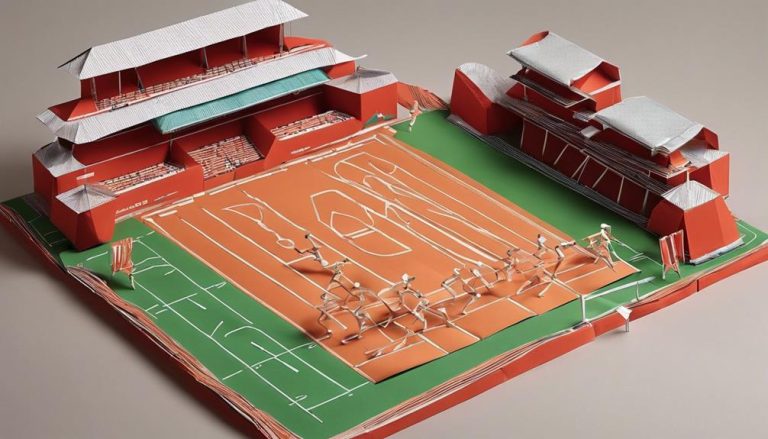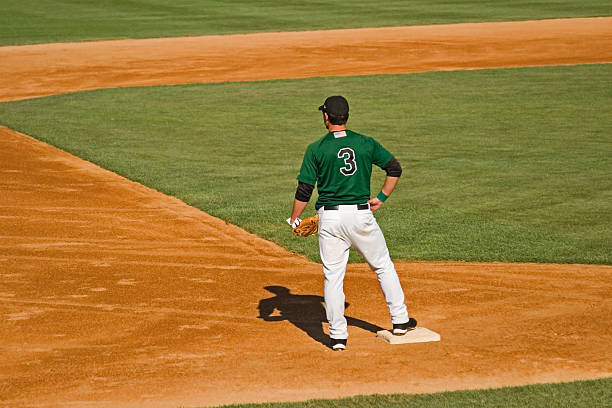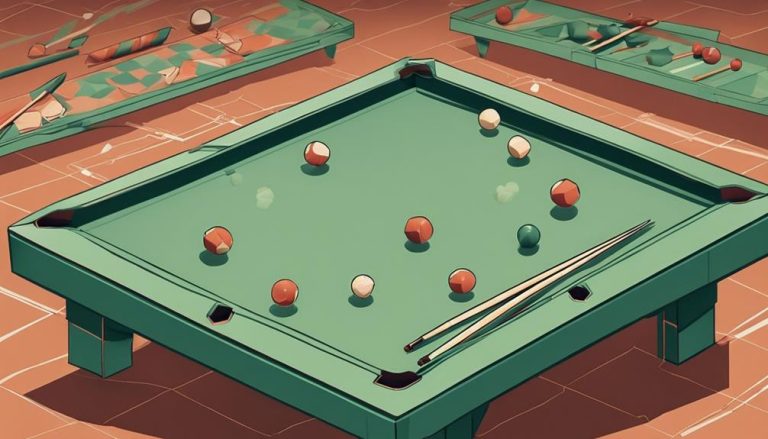General Rules of Paddle Tennis
When it comes to paddle tennis, we all know that 'practice makes perfect.' But have you truly grasped the nuances of the game? Understanding the general rules can make a significant difference in your gameplay. From the scoring system to player positions, each aspect plays a pivotal role in your performance on the court. So, are you ready to elevate your paddle tennis skills to the next level?
Scoring System
When playing paddle tennis, understanding the scoring system is important to keep track of points efficiently. In this game, points are scored just like in regular tennis, with 15, 30, 40, and the game being won at 40 if the leading player wins the next point. However, if both players reach 40, it's called a 'deuce.' From deuce, a player must win two consecutive points to win the game.
Tiebreak rules come into play when the score reaches 6-6 in a set. In a tiebreak, the first player to reach 7 points with a margin of 2 wins the set. Unlike in tennis, the tiebreak is played to 7 points, not 10. This can be an important moment in a match, so staying focused and playing each point strategically is key.
When it comes to strategy tips, remember that paddle tennis is a game of angles. Use the walls to your advantage, aiming your shots to bounce close to the walls, making it harder for your opponent to return. Additionally, communication with your partner is crucial in doubles matches. Make sure to have a clear plan for who will hit certain shots and cover specific areas of the court. By working together and staying strategic, you can outsmart your opponents and secure victory on the paddle tennis court.
Court Dimensions
To understand the dynamics of paddle tennis fully, it's important to grasp the specific dimensions of the court where the game is played. The standard paddle tennis court is 50 feet long and 20 feet wide, with a net stretched across the middle. The net height is 31.5 inches at the ends and 33.5 inches in the middle. This slight elevation in the middle helps prevent the ball from rolling under the net during play.
The court surface is usually made of artificial grass or artificial turf, providing a consistent and predictable playing field. The choice of surface can affect the speed and bounce of the ball, adding an extra layer of strategy to the game.
Court markings are vital for determining in-bound and out-of-bound shots. The court is divided into two halves by the net, and each side has a service box where players must stand to serve. The service boxes are marked with lines to guide players on where to position themselves for serving.
When it comes to player equipment, paddle tennis requires a solid paddle and a low-compression ball. The paddle is typically made of composite materials and has small holes to reduce air resistance, allowing for better control and power in shots. The low-compression ball is designed to bounce lower than a regular tennis ball, suiting the dimensions of the paddle tennis court. Understanding these court dimensions and equipment specifics sets the stage for an exciting paddle tennis match.
Serving Rules
When serving in paddle tennis, understanding the serve placement rules is essential. Ensuring your serve lands within the designated boundaries is key to scoring points. Remember to be mindful of faults and lets to keep the game fair and enjoyable for all players.
Serve Placement Rules
Understanding the correct placement for serving in Paddle Tennis is important for a fair and efficient gameplay. Proper technique is vital when serving in Paddle Tennis. Your serve should be hit diagonally across the court towards the opposite service box. This strategic placement can put pressure on your opponent and give you an advantage in the point. When serving, aim to hit the ball deep into the service box to make it harder for your opponent to return. Additionally, varying your serve placement can keep your opponent guessing and increase your chances of winning points. By mastering the proper technique and strategic placement of your serves, you can elevate your Paddle Tennis game and outsmart your opponents.
Fault and Let
Mastering the rules of fault and let in Paddle Tennis is important for maintaining a fair and smooth gameplay experience. Let etiquette is vital in Paddle Tennis, where a let is called when a served ball hits the net but still lands in the correct service court. In such cases, a let is played, and the server gets another opportunity to serve without penalty. When a serve hits the net and lands outside the correct service court, it results in a fault. Fault resolution involves the server losing that serve, and the opponent gains a point. Understanding the distinctions between a let and a fault, and following let etiquette, is fundamental for a harmonious and fair Paddle Tennis match.
Player Positions
Positioning yourself strategically on the paddle tennis court can greatly impact your gameplay and overall performance. When it comes to player positions, understanding the dynamics of net play and defensive strategies is vital.
Net play in paddle tennis involves taking an offensive stance near the net to intercept shots and put pressure on your opponents. By positioning yourself close to the net, you increase your chances of executing volleys and smashes effectively, putting the opposing team on the defensive. Effective net play requires quick reflexes and a keen eye to anticipate shots.
On the other hand, defensive strategies are important for maintaining control during rallies and regaining the advantage if you find yourself in a difficult position. Staying back near the baseline allows you to defend against powerful shots and gives you more time to react to your opponent's moves. Communicating with your partner to coordinate your defensive efforts effectively and cover all areas of the court.
Communication and teamwork dynamics play a significant role in determining player positions. Clear and concise communication with your partner makes sure that you both understand each other's intentions and can adjust your positions accordingly. Working together as a team enhances your overall performance and allows you to capitalize on each other's strengths. By mastering player positions and understanding the nuances of net play and defensive strategies, you can elevate your paddle tennis game to new heights.
Faults and Penalties
When playing paddle tennis, being aware of faults and penalties is essential to maintaining fair gameplay and avoiding unnecessary point deductions. Understanding common faults and rule violations can help you play with integrity and respect for the game. Here are some key points to keep in mind regarding faults and penalties:
| Common Faults | Player Behavior |
|---|---|
| Foot faults | Unsportsmanlike conduct |
| Double bounces | Hindering opponent |
| Out of bounds shots | Coaching during play |
| Hitting the net | Delay of game |
Penalty enforcement is crucial in ensuring that the game is played fairly and that all players adhere to the rules. If a fault or rule violation occurs, the penalty will be enforced accordingly. This could result in the loss of a point, a side out, or other consequences depending on the severity of the infraction. It is important to respect the rules of the game and the decisions of the officials to maintain the integrity of paddle tennis.
Match Procedures
When starting a paddle tennis game, remember that you need to score points to win. The scoring system in paddle tennis can sometimes be confusing, but once you understand it, you'll be able to keep track of the game easily. Pay close attention to the points you and your opponent earn to determine who wins each match.
Game Start
To commence a game of paddle tennis, players must first confirm they are positioned correctly on the court according to match procedures. Once you're in the right spots, follow these steps for a smooth start:
- Gear Check: Confirm all players have the required gear, including paddles and appropriate footwear.
- Warm-Up: Take a few minutes to warm up your muscles and get into the rhythm of the game.
- Serve Choice: Determine who will serve first through a coin toss or mutual agreement.
- First Serve: The player who wins the serve choice will start the game by serving from behind the baseline.
Scoring System
Once the game has commenced with the serve, the scoring system in paddle tennis follows a straightforward and competitive structure designed to determine the winner. In paddle tennis, matches are typically played to 7 points. However, if the score reaches 6-6, a tiebreaker is played to determine the winner. Here is a breakdown of how scoring works in paddle tennis:
| Points | Outcome |
|---|---|
| 0-2 | Love |
| 3 | 40 |
| 4 | 40, Advantage In |
| 5 | 40, Advantage Out |
| 6 | Set Point |
| 7 | Game |
Strategy Tips: Stay close to the net, aim for your opponent's weaker side, and communicate effectively with your partner.
Common Mistakes: Hitting the ball too hard, failing to anticipate your opponent's shots, and not moving as a team.
Frequently Asked Questions
Can Players Switch Sides During a Match in Paddle Tennis?
Sure thing! In paddle tennis, players can switch sides during a match. This strategic move allows for better positioning and can give you an advantage. Remember, the side changes can be pivotal in determining the outcome.
Are There Any Restrictions on the Type of Paddles That Can Be Used in Paddle Tennis?
When playing paddle tennis, you can freely choose your paddle materials, but make sure they adhere to regulations. Grip size and customization are essential for comfort and performance. Enjoy the freedom to personalize your gear!
Is There a Time Limit for How Long a Match Can Last in Paddle Tennis?
Ever wondered about the ticking clock in paddle tennis matches? Well, worry not! In this exhilarating game, there's no strict time limit for match duration, but tiebreakers may come into play to keep things moving.
Are There Any Specific Rules Regarding Attire or Equipment That Players Must Adhere To?
When playing paddle tennis, comply with the dress code and equipment requirements. Make sure that your attire is appropriate and your gear meets the standards. Additionally, uphold good sportsmanship by following the conduct rules during matches.
How Often Should the Balls Be Replaced During a Paddle Tennis Match?
You may wonder if the ball durability affects gameplay. In paddle tennis, players often replace balls every 6 to 8 matches based on player preference. Ball rotation maintains quality, ensuring a consistent game experience.






